Linda Lam
The 100 degree club is elusive for many cities, but others can count on being a member every year.
High temperatures soar past the century mark each summer in some areas of the United States and blistering heat becomes the norm. For some locations, triple digit heat can last for months, but for others, it has never happened since records began.
Climate and geography can have major impacts on how often cities experience temperatures climbing to 100 degrees. Below, we take a look at some interesting statistics on triple digit heat across the Lower 48.
The Desert Southwest is where 100 degree heat is most common. Many cities in the West typically experience temperatures above the century mark every year and that's particularly the case in the Desert Southwest.
Las Vegas, Phoenix and Tucson are all premium members of the triple digit club, as the average number of 100 degree days for all three cities is well above 50 per year. The highest temperature on record in Las Vegas is 117, which has been reached several times, most recently in 2021.
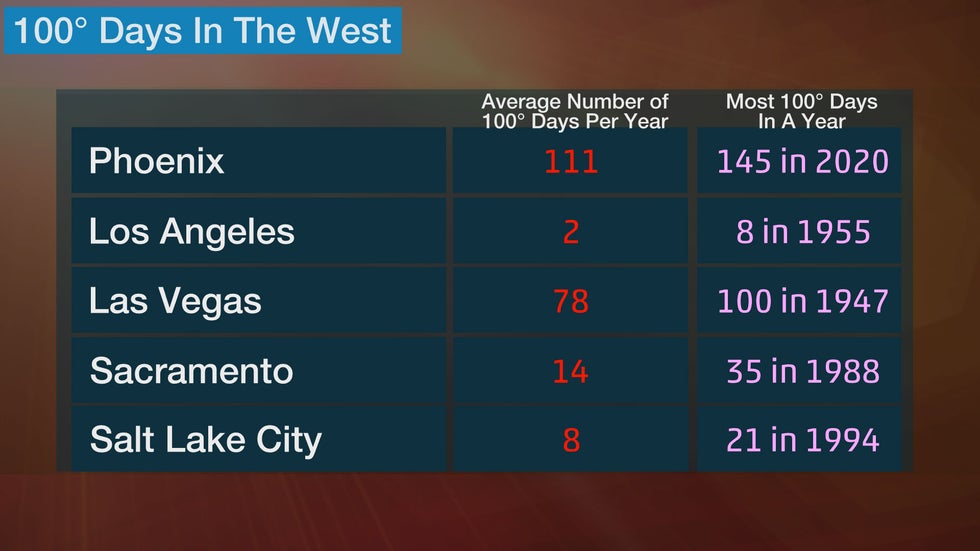 Averages are based on 1991-2020 climate data.
Averages are based on 1991-2020 climate data.Death Valley comes to the minds of many when thinking of very hot conditions because it holds the world record for the hottest temperature at 134 degrees, set July 10, 1913.
The average number of 100 degree or hotter days per year in Death Valley is an astonishing 147, just two days more than the current record for the most such days in Phoenix, which was set in 2020. Last year, temperatures in Death Valley reached at least 100 degrees 160 times.
(MORE: Death Valley Heat Records)
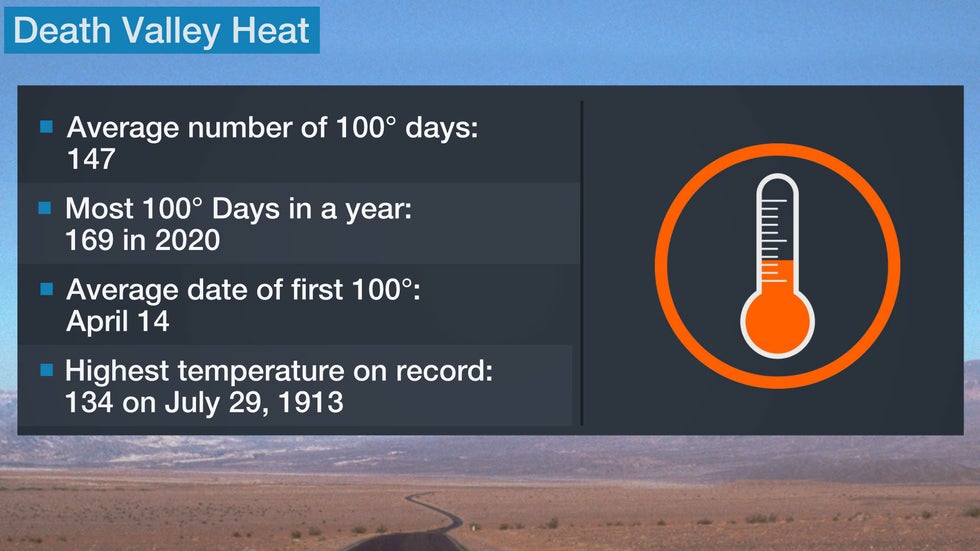
Triple digit temperatures are less common elsewhere in the West. Unsurprisingly, Seattle and Portland, Oregon, often do not have 100 degree days. Seattle has only measured a 100 degree reading six times, two of which were during the historic heat wave of June 2021 when its highest temperature on record of 107 degrees was reached. Portland also set a new record for highest temperature during that heat wave when the high hit 117.
Triple digit temperatures are more common east of the Cascades; Even locations in Montana soar to 100 degrees from time to time. The most 100 degree days in Missoula, Montana, were 11 in 2007, and in 2022, there were 10 days with a high of at least 100. The highest temperature on record there is 107.
(MORE: Here's When The First 90 Degree Highs Of The Year Typically Happen)
What's behind the heat, or lack thereof, in the West? These very hot conditions are due to a combination of factors, including elevation, humidity and location.
Locations farther south in the U.S. benefit from a higher sun angle, which results in an increase in solar radiation. Lower elevations also tend to experience higher temperatures, as temperatures decrease when moving higher into the atmosphere. Air tends to be drier in much of the West in the summer, and dry air is able to warm up more readily than moist air.
Temperatures in areas closer to the West Coast are influenced by the cool Pacific Ocean, reducing the 100 degree heat there.
Triple digit heat is common in the Plains. Downsloping winds from the Rocky Mountains can aid in higher temperatures, and the region's location between the Rockies but also far enough away from the Gulf of Mexico can lead to drier air.
The Southern Plains has several cities in the triple digit club and experiences more frequent extreme heat compared to the Northern Plains due to the difference in latitude.
Dallas is one of those cities. The average date for the first of many 100 degree days is July 3. The year with the most 100 degree temperatures in Dallas was 2011 when highs topped the century mark 71 times. That year, exceptional drought was widespread across the region.
To the southwest in El Paso, Texas, 27 days per year typically have triple digit temperatures. Farther north in Oklahoma City, there are about 13 days per year when the mercury reaches 100 degrees or higher; Last year, there were 24 such days.
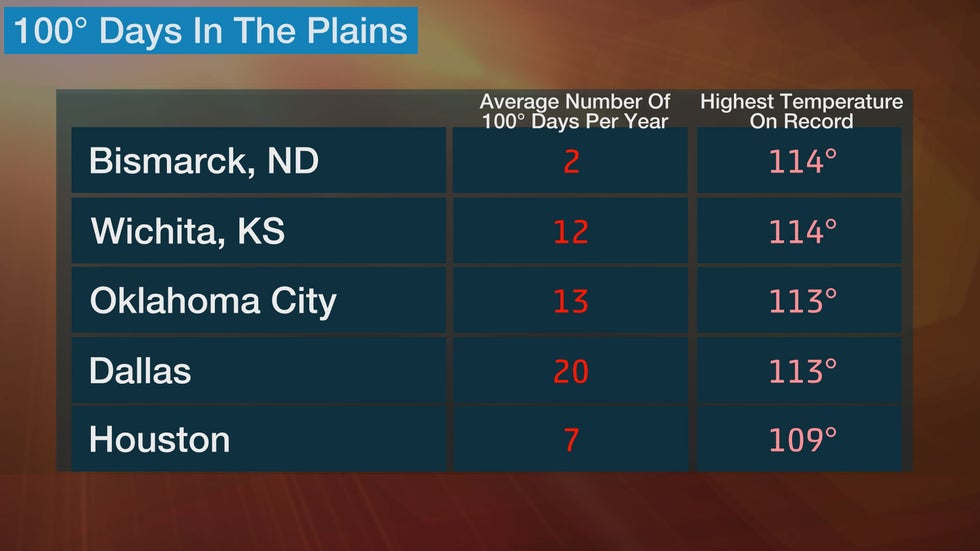 Averages are based on 1991-2020 climate data.
Averages are based on 1991-2020 climate data.The 100 degree mark becomes a little more elusive closer to the Gulf of Mexico due to the increase in moisture. Houston usually only experiences seven days each year with a high of at least 100. There are even fewer 100 degree days in Brownsville, Texas, where the average is two days per year. The most recorded in a year there is 12 in 2019.
The Northern Plains experiences its share of triple digit heat, usually when a strong upper level ridge of high pressure builds across the region.
The highest temperature on record for the North Dakota towns of Bismarck and Fargo is 114 degrees and was set in July 1936. Many cities in the Central and Northern Plains set temperature records and saw the greatest number of 100 degree days during the Dust Bowl in 1936. North Dakota even reached 121 degrees near Steele on July 6, 1936.
(FORECAST: Summer 2023 Outlook)
The Midwest can experience 100 degree days. Temperatures can soar to 100 degrees or higher in the Midwest, most often when high pressure dominates the region in the summer with a southerly flow.
St. Louis and Kansas City both usually see about three days of 100 degree temperatures each year. Last year, St. Louis experienced seven 100 degree days, while Kansas City had three days.
Much of the region experiences triple digit heat every few years.
The highest temperature on record in both Chicago and Milwaukee is 105 degrees, set July 24, 1934. Both cities also saw the most 100 degree days in 1988 – seven in Chicago and six in Milwaukee. A widespread drought took hold in portions of the U.S. in 1988, contributing to the extensive and unusual heat.
Many other cities in the Midwest set temperature records in 1936 and were influenced by the Dust Bowl just like in the Plains.
Minneapolis saw the most 100 degree days on record in 1936, with nine. Detroit and Indianapolis also set records for the most 100 degree temperatures in 1936, with eight and 12, respectively. The last time Detroit or Indianapolis reached 100 degrees was in July 2012, while Minneapolis recorded a high of 101 degrees on June 20, 2022.
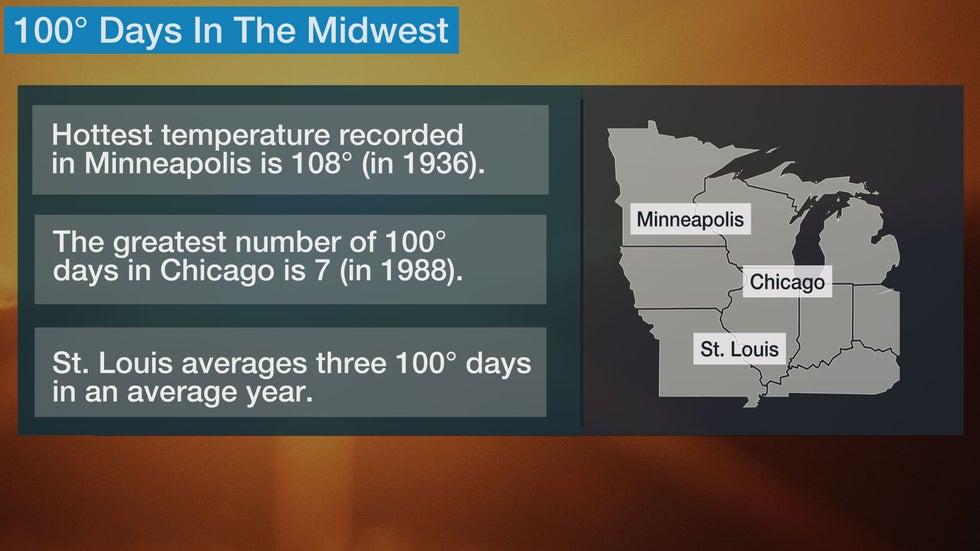 Averages are based on 1991-2020 climate data.
Averages are based on 1991-2020 climate data.Temperatures can sizzle in the South, too. Although the South certainly experiences hot conditions each summer, 100 degree temperatures are not as common as one might think.
The region is at a latitude conducive for triple digit heat, but higher dew points and humidity levels, as well as proximity to the Gulf of Mexico and the Atlantic Ocean, inhibit higher temperature readings.
Occasionally, a hot and dry air mass develops across the region and allows the mercury to soar across the South. Areas farther from the water typically have a better chance of seeing triple digit heat.
Nashville had 20 days of 100 degree highs in 1954. The highest temperature on record there is 109 degrees, set June 29, 2012. The next day, Atlanta set its highest temperature – 106 degrees. Nashville reached the 100 degree mark last year for the first time since then. The last time Atlanta reached at least 100 degrees was August 2019.
Closer to the Gulf of Mexico, New Orleans and Mobile have seen far fewer 100 degree days. The most recorded in a year for New Orleans is five in 1980 and eight in 2000 for Mobile.
Florida is usually thought of as hot and humid, but the persistent humidity plays a large role in limiting how high the thermometer goes.
Tampa has never recorded a high of 100 degrees in records dating to 1890. The mercury only climbed to 100 degrees once in Miami, on July 21, 1942. Away from both coasts, Orlando has reached 100 degree highs several times, most recently on June 19, 2015.
Even though the thermometer may not read 100 degrees often, the combination of heat and humidity can make it feel like 100 or higher based on the heat index.
(MORE: What Is The Heat Index?)
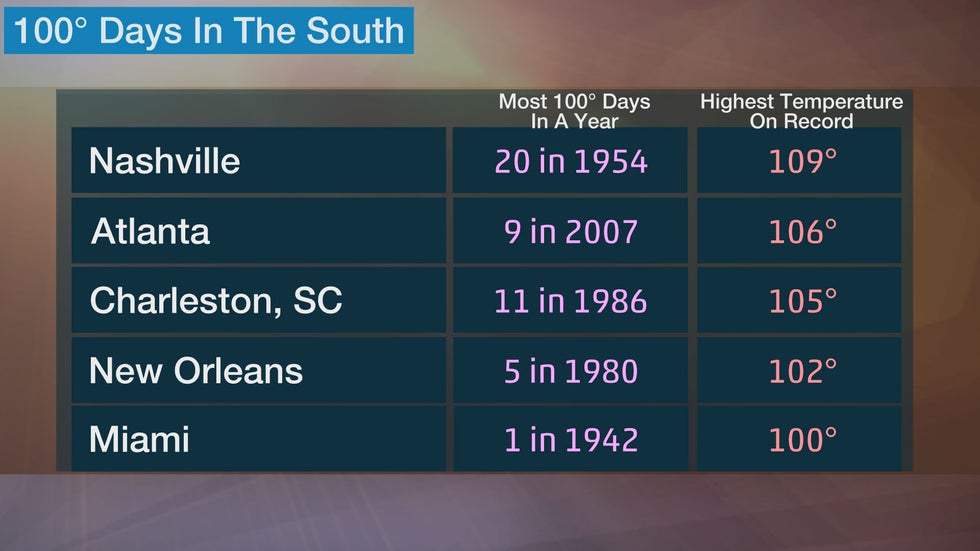
The Northeast typically escapes triple digit heat. The lack of triple digit temperatures in the Northeast is due to the region's higher latitude and general lack of dry air.
However, the right setup sometimes takes shape with a strong area of high pressure over the region that allows temperatures to rise above 100 degrees.
Triple digit heat is slightly more common closer to the mid-Atlantic. Baltimore last reached 100 degrees in July 2020, while it last happened in August 2016 for Washington, D.C. New York City last reached 100 degrees in July 2012, while Boston hit 100 on July 24, 2022.
Portland, Maine, and Burlington, Vermont, have also cracked the triple digit mark; The highest temperature on record is 103 degrees in Portland and 101 in Burlington.
Some cities in the region have never recorded a 100 degree high, including Buffalo, New York, and Caribou, Maine.
(MORE: Heat Safety)
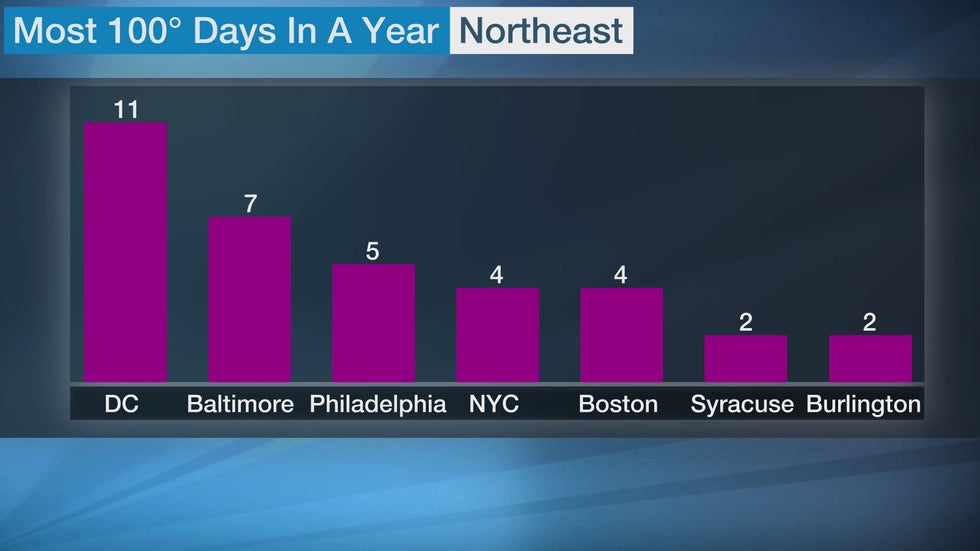
The Weather Company’s primary journalistic mission is to report on breaking weather news, the environment and the importance of science to our lives. This story does not necessarily represent the position of our parent company, IBM.
The Weather Company’s primary journalistic mission is to report on breaking weather news, the environment and the importance of science to our lives. This story does not necessarily represent the position of our parent company, IBM.

No comments:
Post a Comment